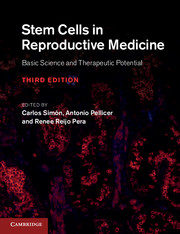Book contents
- Stem Cells in Reproductive Medicine
- Stem Cells in Reproductive Medicine
- Copyright page
- Contents
- List of contributors
- Preface
- Part 1 Female gamete
- Part 2 Male gamete
- Part 3 The embryo/blastomere
- 6 Meiotic recombination in human oocytes
- 7 Gene expression dynamics during human embryonic development
- 8 Embryonic stem cells from blastomeres maintaining embryo viability
- 9 Gamete generation from stem cells to avoid gamete donation and customized hESCs from blastomeres as the cellular insurance for the newborn: Will it ever be ethically acceptable?
- Part 4 Trophoblast, amniotic fluid, endometrium, and bone marrow
- Part 5 New developments in stem-cell research
- Index
8 - Embryonic stem cells from blastomeres maintaining embryo viability
from Part 3 - The embryo/blastomere
Published online by Cambridge University Press: 05 July 2013
- Stem Cells in Reproductive Medicine
- Stem Cells in Reproductive Medicine
- Copyright page
- Contents
- List of contributors
- Preface
- Part 1 Female gamete
- Part 2 Male gamete
- Part 3 The embryo/blastomere
- 6 Meiotic recombination in human oocytes
- 7 Gene expression dynamics during human embryonic development
- 8 Embryonic stem cells from blastomeres maintaining embryo viability
- 9 Gamete generation from stem cells to avoid gamete donation and customized hESCs from blastomeres as the cellular insurance for the newborn: Will it ever be ethically acceptable?
- Part 4 Trophoblast, amniotic fluid, endometrium, and bone marrow
- Part 5 New developments in stem-cell research
- Index
Summary
Keywords
- Type
- Chapter
- Information
- Stem Cells in Reproductive MedicineBasic Science and Therapeutic Potential, pp. 84 - 92Publisher: Cambridge University PressPrint publication year: 2013



